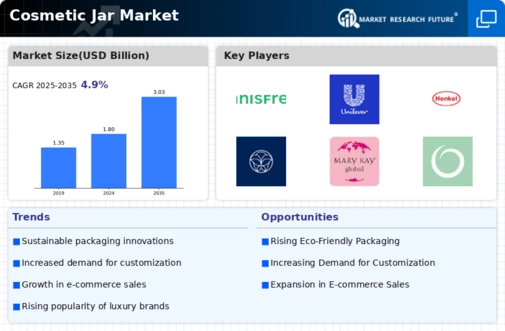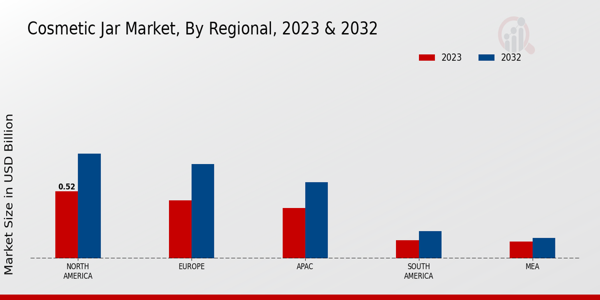Market Growth Chart
Growth of the Skincare Sector
The Global Cosmetic Jar Market Industry is significantly influenced by the expansion of the skincare sector. With an increasing focus on skincare routines, particularly among younger demographics, the demand for cosmetic jars is on the rise. Brands are launching a variety of skincare products, including creams, serums, and masks, which require effective packaging solutions. This growth is reflected in the projected market value of 3.03 USD Billion by 2035, suggesting that the skincare segment will continue to drive the demand for cosmetic jars in the coming years.
Rising Demand for Sustainable Packaging
The Global Cosmetic Jar Market Industry is experiencing a notable shift towards sustainable packaging solutions. Consumers increasingly prefer eco-friendly materials, prompting manufacturers to innovate with biodegradable and recyclable options. This trend aligns with the growing awareness of environmental issues and the desire for responsible consumption. As a result, brands that adopt sustainable practices may enhance their market position and appeal to environmentally conscious consumers. The market is projected to reach 1.8 USD Billion in 2024, indicating a robust demand for sustainable cosmetic jars that cater to this evolving consumer preference.
Technological Advancements in Packaging
Technological advancements are reshaping the Global Cosmetic Jar Market Industry by introducing innovative packaging solutions. Developments in materials science and design technology allow for the creation of jars that are not only aesthetically pleasing but also functional. Features such as air-tight seals and UV protection are becoming standard, enhancing product longevity and consumer satisfaction. As brands strive to differentiate themselves in a competitive landscape, these technological innovations may play a crucial role in attracting consumers and retaining market share, thereby contributing to the industry's growth.
Influence of Social Media and Beauty Trends
The influence of social media and emerging beauty trends is a significant driver of the Global Cosmetic Jar Market Industry. Platforms such as Instagram and TikTok have transformed how consumers discover and engage with cosmetic products. Influencers and beauty gurus often showcase products in jars, creating a visual appeal that drives consumer interest and purchasing behavior. This phenomenon not only boosts brand visibility but also encourages consumers to experiment with new products, thereby expanding the market. As trends evolve, the demand for innovative and visually appealing cosmetic jars is likely to increase.
Increasing Urbanization and Disposable Income
Urbanization and rising disposable incomes are pivotal factors driving the Global Cosmetic Jar Market Industry. As more individuals move to urban areas, there is a corresponding increase in the demand for cosmetic products, including those packaged in jars. Higher disposable incomes enable consumers to invest in premium skincare and cosmetic products, further fueling market growth. This trend is expected to sustain the industry's expansion, as urban consumers often prioritize personal care and beauty, leading to a projected CAGR of 4.85% from 2025 to 2035.










